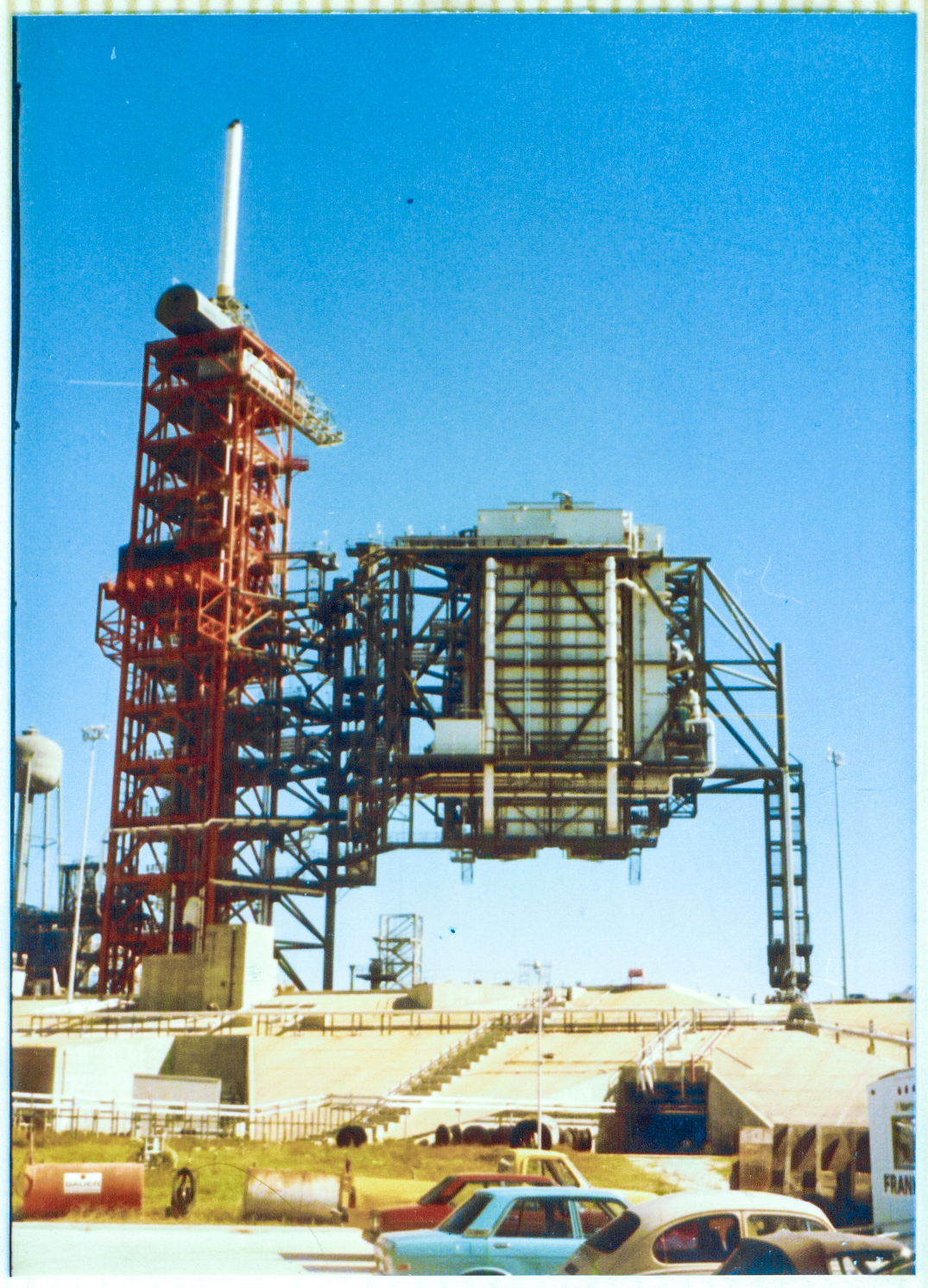Space Shuttle Launch Complex 39-B Construction Photos
Page 58
RSS First Rotation (Original Scan)
This was a Big Deal. This was the first time that the Rotating Service Structure, this gigantic multi-million pound mobile high-rise hotel of a Wonder of the World, was actually set into motion and rotated. Actually moved. Big hotels are not meant to be rolled across the street, and yet...
And when you are dealing with mobile objects of this size and weight, you really REALLY do not want anything to go wrong. So the first time you roll, there's a lot on the line. I snapped these shots from in front of the Sheffield field trailer.
I had wanted to go up on the pad deck to get a look at things from close range, but my boss was up there, and somebody had to stay back in the trailer and man the phone, and that somebody was me. Turned out to be a lucky thing. Otherwise, I would not have gotten this sequence of photographs of the rotation.
A friend of mine took a quarter, dime, and penny I gave him, and placed them on the rail, one on top of the other. The RSS smashed the stack flat, all smeared out of shape and with each coin's impression embedded into each other. It was my thirty-six cent sandwich. Somehow, along the intervening years, I managed to lose it somewhere. But it was fun to show people while I still had it.
Everything worked fine with this first rotation. Perfectly, in fact. Just like it was supposed to.
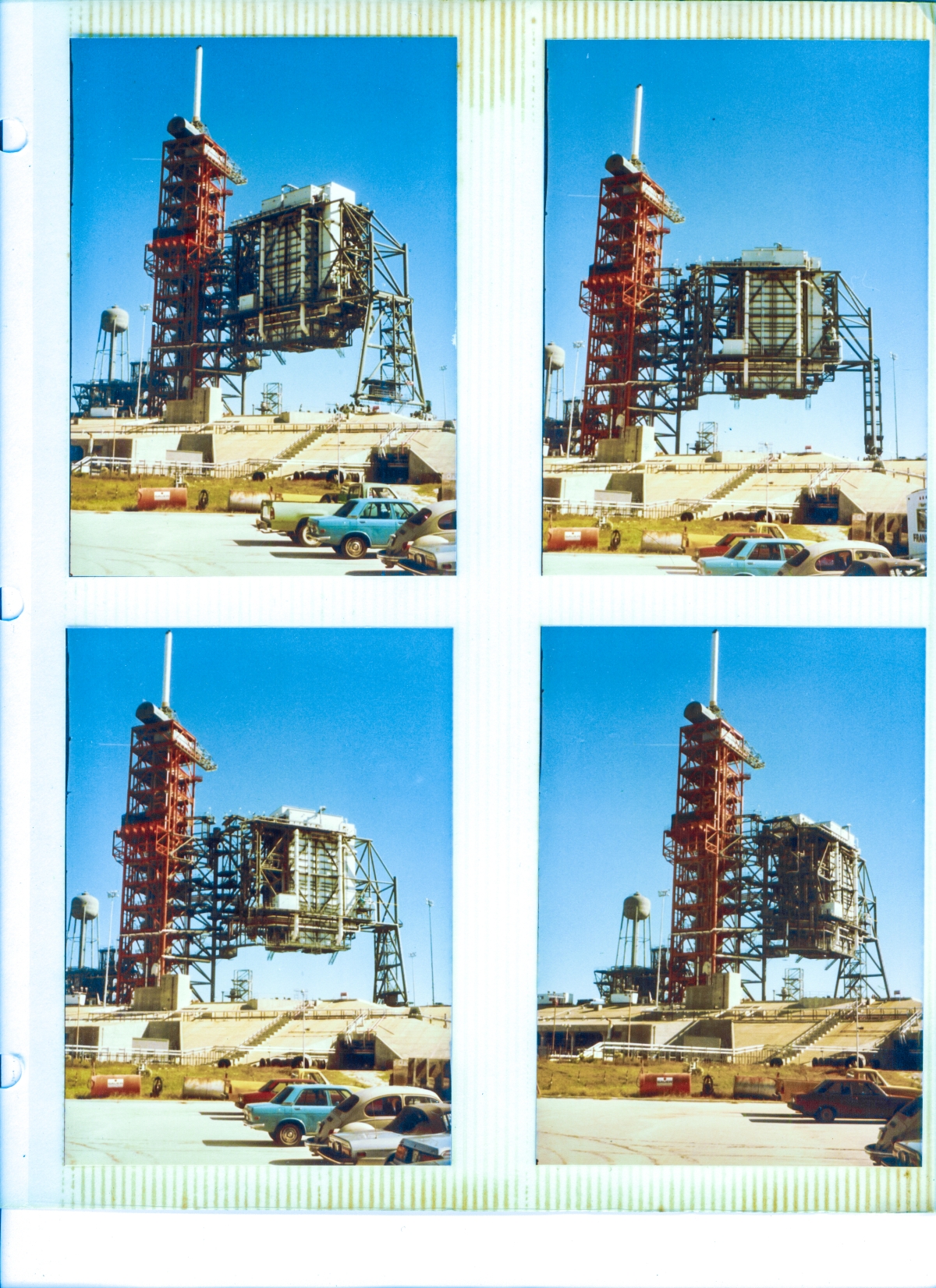
Top Left: (Full-size)
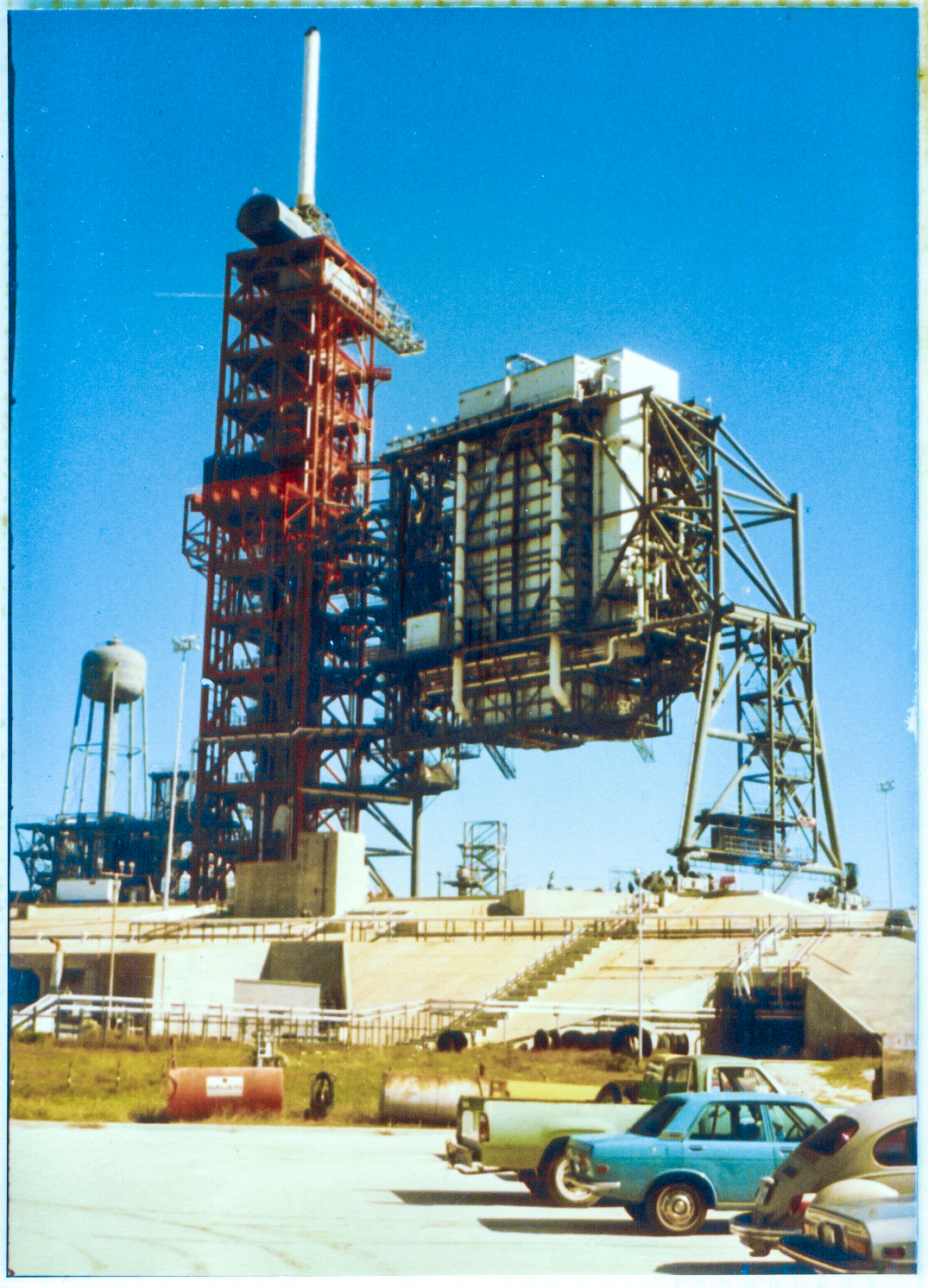
And over the years its bones rose up into the sky as a great edifice of steel, and its sinews and its muscles, and its veins and its arteries, and its nerves and its eyes, and it all filled in and filled out and grew and put on weight and was in stasis, was in suspension, like something inside of a chrysalis, not yet, but yet, and for the whole time, for years, it remained in place, still, lifeless but living, until the chrysalis is broken, and it wakes up and it comes alive.
And when it begins to move, all that had come before is revealed as illusion, and the new reality, the new life, now takes its place, and you see things about it you had known all along were going to come true, but when they really do come true, you cannot help but stand in awe, stand in wonder, knowing exactly what you're seeing and yet being spellbound by it as if nothing like it in the world could ever have been imagined.
And it is dead silent as it moves. Millions of pounds of dead silence.
No sound is made.
No metal against metal. No sound of motor. No horn, no whistle. No shouts, no voices of any kind. You are standing all alone, just yourself and your thoughts, in a deserted parking lot, watching this thing. Watching this thing... .. ...move.
And you stand, looking at it... awestruck.
And it simply, ever so slowly, quits being here...
...and enters a state of becoming there.
It is.
No longer.
Where it was.
I cannot put this into words.
Too-quick of a glance at this image, and you might not realize things are now different, and so we will give you a link to one of the photographs I took of the tower before it was placed into motion, from the exact same location, with Column Line A-7 outlined in yellow, the Drive Truck outlined in red, and the extra bit of supporting concrete that was added to the pad deck to carry the load of Line A-7 when the RSS was in the demate position highlighted in blue, so that you can see the slight, but very significant, differences in things. Once you are aware of where things were located before the RSS was moved, you can see in the image above these words that it's no longer in the same place. The RSS is underway.
In the following images, the RSS will be facing us from directions that we have, up to this point, never had the opportunity to see, and it will allow us to visualize certain details that have been difficult or impossible to make out in the photographs, and I'll be pointing some of this out and using the structural drawings as references, as I go along.
Top Right: (Full-size)
Another one of my favorite images that I ever got, the entire time I was out here.
The RSS is being viewed squarely. From behind. Located precisely on the centerline of the tower as defined by Column Line 4.
It might be of some help, before we go further, to remind ourselves that the flat face of the RSS that we're seeing isn't quite as flat as we might at first glance imagine.
Part of it slopes away from us at a sharp angle, and the part that slopes away is the part in this image where the steel is thickest, and therefore least understandable, visually.
The part that slopes away is the part between Column Lines 1 and 2, and if you look down in the extreme bottom right corner of the linked image, you will see that I've highlighted the Key Plan, and when you look at that, you can see that this part of the RSS Main Framing really is sloping away from you at a steep angle, and since things are starting to get a little hairy with this thing pivoting around, I've also altered that part of the Key Plan which shows the orientation of the RSS with the FSS, to bring it in line with what you're actually seeing in the photograph, and the highlighting in the Key Plan covers just the main perimeter framing members of the RSS Lines 1 and 2, plus the Hinge Column Struts, plus the FSS.
Phew.
Column Line 1, the Hinge Column, is 35 feet farther away from us than Column Line 2, which is where the main "body" of the RSS begins, although in this image that's hard to tell, because the thicket of steel between Lines 1 and 2 is so dense that it could cause you to believe things start over there at Column Line 1, but they don't. The Main Floor of the RSS (a structural drawing of which, alas, I've never been able to get my hands on), would show this clearly, but I do not have that, so instead I'm going to use what I have, which is a paste-up of the PCR Area with Main Framing Line Numbers inserted from another drawing, and all of it yellow highlighted.
All the way across the RSS, over on the Column Line 7 side of things, there is further interestingness with perspective.
The RSS is significantly above us, and that shows clearly in the perspective of the main horizontal and diagonal framing members between Lines 6 and 7, and since the members on (or connect diagonally with) Line B are farther away from us at Line B, they are very reasonably showing in the photograph below the Line A horizontal and diagonal Main Framing. Give the photo a look. Verify this for yourself.
This is all just as it should be, and it's the sort of thing that's so obvious, that nobody ever actually sees it.
Ok, fine. So what?
Well, what about the vertical members on Line 7?
One would expect that, since we're aligned precisely on the front-to-back centerline of the RSS, on Line 4, then the same sort of perspective effect should apply to things off to the side, as well as things up above us, and one would be perfectly justified in that expectation, except that the vertical member on Line 7, farther away from us, on Line B, is nowhere to be seen!
Why?
And of course we've been looking at the reason for so long that we've forgotten there even is a reason, and now that we're thinking about it right now, the reason completely escapes us.
Let us look again at the Plan View of the RSS Main Framing at Elevation 135' to see what's going on.
And there it is.
Column Line 7 isn't square with the rest of the RSS, and in fact, the vertical member at A-1 is
3 feet, 11 and one-quarter inches closer to Line 6, than the member at B-1. The box defined by the corners at Lines A-6, A-7, B-6, and B-7, isn't a box at all. It's a right trapezoid. And that angled aspect of the trapezoid out there along line 7, just happens to strike a line which points almost exactly toward the place where I was standing, on a different line which is struck along the side-to-side centerline of the RSS at Line 4.
I just happened to be standing on the place where the two lines crossed.
Pure coincidence.
Which may or may not be interesting to anyone on its own terms, but it further becomes interesting in that it's allowing us to look directly along the Main Framing of Line 7, which allows us to see that the Stair Tower on Line 7 is neither inboard nor outboard of the main envelope of the RSS, but instead straddles Line 7, part of it inside the envelope of the RSS, and part of it outside the envelope of the RSS.
Which is no big deal in and of itself, except for the fact that images which show this little slice of information are, so far as I know, almost nonexistent. For anybody in the world, for any reason whatsoever, who might want to see how this end of things is put together with the Stair Tower on Line 7, this is one of only two images, anywhere, which lets you see this precisely. The other similar image shows the RSS on Pad A being built (spanning the Flame Trench) by Wilhoit, and the alignments of things are not quite as precise.
Of yet further interest is why?
Why is Line 7 at a cocked-ass angle to the rest of the whole goddamned RSS?
Why would they go to all the very significant time and trouble and expense to do such a thing?
There had to be a reason, so what is it?
And when you think about that, you may or may not realize that it's because the RSS rotates.
It is, after all, a Rotating Service Structure, and things that rotate follow, in some way, a curve, and the curve that the RSS follows is defined by a circular arc which is defined by its pivot point, which is the center of the Hinge Column.
And Column Line B, the front of the RSS, the business end of the RSS, where it meets the Space Shuttle when it's rotated around into its Mate Position, extends out away from the center of the Hinge Column in a straight line.
Ok, fine.
So what?
Well... the RSS contains the PCR, where almost all the work gets done, and as with so many other things designed by and for humans with an eye toward getting work done, the PCR is a nice square rectangular box, and for that to happen, the back side of the PCR, the side that runs along Column Line A, has to be parallel with the front side, which runs along Column Line B, and for that to happen, the line formed by Column Line A can never intersect with the Hinge Column.
Not gonna happen on a square box with an opposite side that intersects the Hinge Column.
But since that which is on the end of Line A is also helping to hold the RSS up in the air, on a curved track having the center of the Hinge Column (which is on Line B) as its defining pivot point, then whatever's out there at the end of Line A needs to be able to successfully sit down directly upon that one-and-only curved track, holding up its side of the RSS, and it's going to have to be exactly the same distance from the center of the Hinge Column as what's holding up the RSS on the end of Line B, and for that to happen, it's gotta be closer to the nice square framing for the PCR which we encounter going inboard from Line 6, than its counterpart on Line B.
Phew.
Lotta damn "phew" around this place if you ask me.
Of other note in this view of the RSS, you're getting what is probably the best view you'll ever get of how the piping runs come in from across the countryside and eventually wind up climbing the FSS (which is the only way any of that stuff is ever going to make it all the way up and into the RSS where almost all of it gets used eventually), and then jump across the Hinge Column Struts from FSS levels 100' and 120' and then head farther across and up, and enter the RSS at elevations 112' and the area just below 135' and from there, they go all over the damn place, sometimes visibly, but oftentimes not, and just to make things even more confusing, there's a whole world of cable trays doing similar stuff, and between ECLSS stuff and Lox and Gox and GH2 and LH2 and both flavors of Hypergol and GN2 and Helium and power and data and about a hundred other things I've never heard of... lotta runs of stuff all headed into and across the RSS from every whichaway.
The white insulated metal paneling which encloses the Anteroom, the PCR and the RSS levels below it, the RSS Elevator, the Hoist Equipment Room, and a wee little sliver of the RCS Room above that, is also on view in a way that makes about as much sense as you're ever going to get of this stuff, just by looking at it.
I like this picture a lot. It's got a lot of cool stuff in it. And I'm pretty sure you're never going to find another picture of the RSS, showing it exactly this way, anywhere.
And I do not really like that very much at all.
It makes me wonder what else is simply gone. Lost forever, never to return, never to be known, never to even be so much as suspected.
The parties who did this work were perfectly capable of collecting and retaining the lost information.
But the parties who held the purse strings ensured that it could never happen, and those are the bastards I would very much like to square accounts with.
Bottom Left: (Full-size)
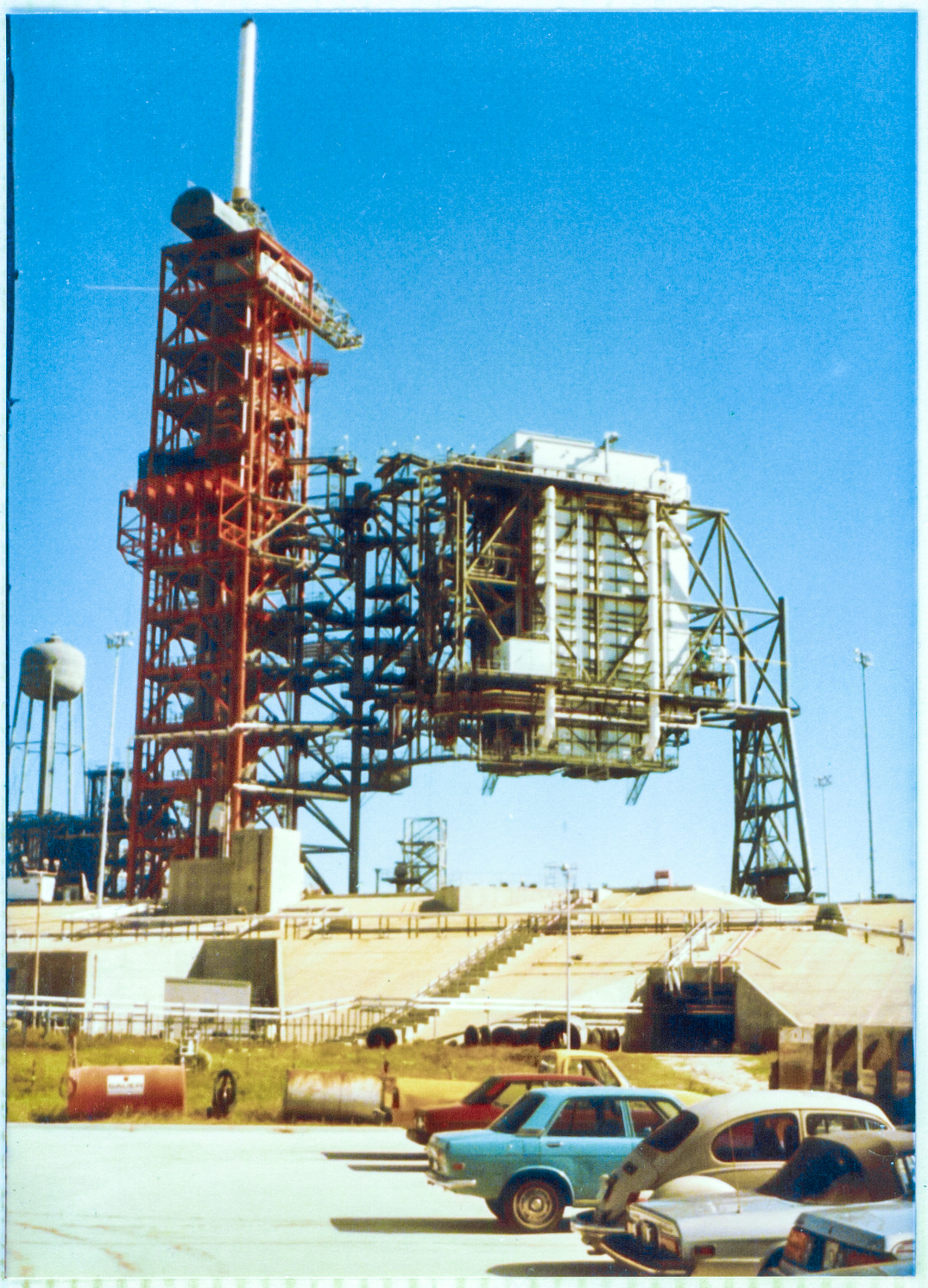
And in the eerie silence, it continues to drift, to wander, to become.
A Great Ship, sailing across dry land.
Bottom Right: (Full-size)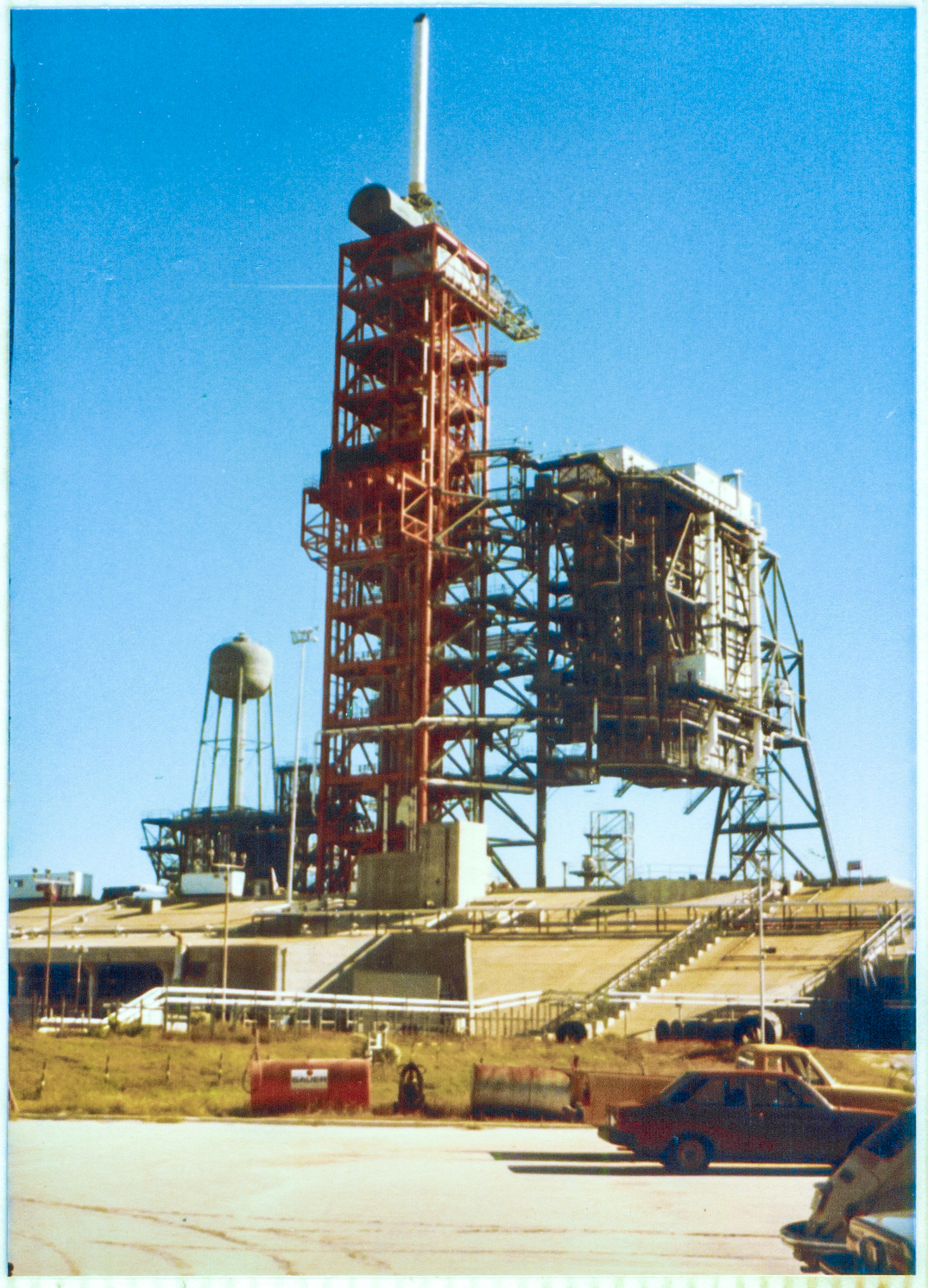
And now we sit at the far end of the arc, and the RSS is no longer in motion, and the pins are thrown into the Hurricane Locks, and all becomes as it was, and all becomes still.
On the other side.
And here, on the other side, one day, there will be other Great Ships come sailing.
Sailing across dry land.
And one day, some of the other Great Ships will sail upwards into the very sky itself.
And not all of those ships will sail safely, come sailing back home again.
And not all of those who sail upon those ships will sail safely, come sailing back home again.
Return to 16streets.comACRONYMS LOOK-UP PAGEMaybe try to email me? |
